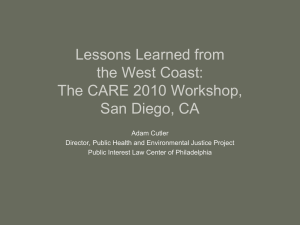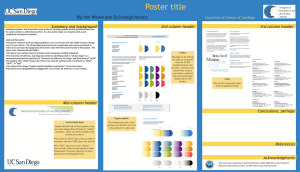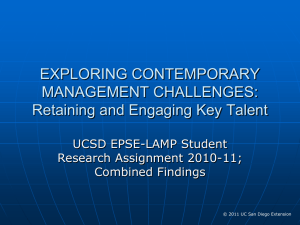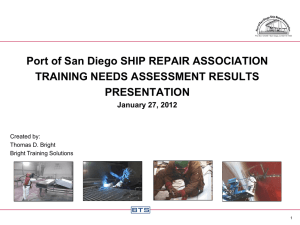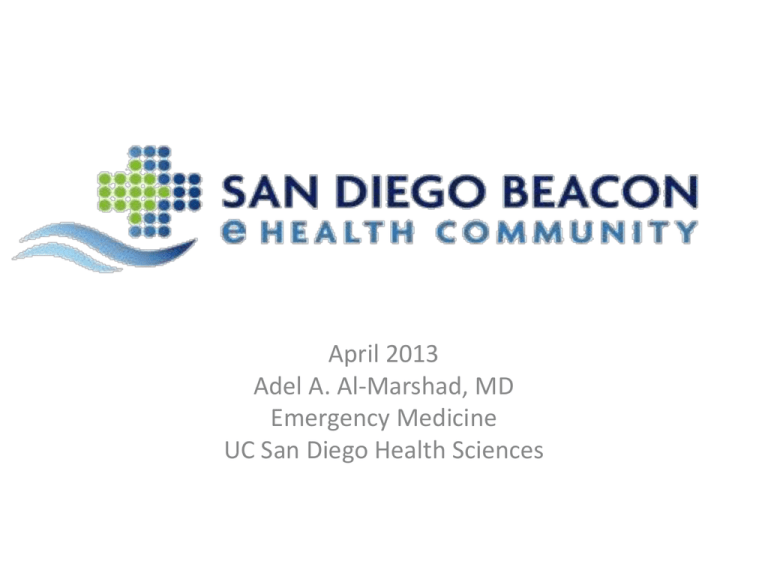
April 2013
Adel A. Al-Marshad, MD
Emergency Medicine
UC San Diego Health Sciences
“ Information should follow the
patient, and artificial barriers –
technical, business-related,
bureaucratic – should not get
in the way ”
– David Blumenthal, MD, Former Director, ONC
Technology, Innovations and Emergency
Medicine – Where is the Value?
• Providers in the ED: Full picture of the patients,
including access to previous tests, becomes available
real time
• Providers in the ambulatory setting: Understanding of
when their patients end up in the ED due to an
exacerbation – could it have been avoided?
• Providers out in the field (EMS): Close alignment with
hospital if acute action is required – long term
potential to generate hot-spotting data.
3
Overview
• Funded by ARRA HITECH Act administered by
the Office of the National Coordinator for
Health Information Technology
• $15 million over three years to use health IT to
improve health care delivery in San Diego as
model for nation
• Transition from a grant-funded initiative to an
self-sustaining independent organization
providing services to the health care
community
4
San Diego
• No dominant health care entity (Scripps,
Sharp, Kaiser, Rady, UCSD)
• 24% of all 30-day readmissions occurs at a
different hospital than the first admission
(nearly 30% for Medi-Cal patients)
• 15% of all ED patients and 69% of “frequent
fliers” were seen in multiple hospitals
San Diego Beacon
• Build and Strengthen Health IT
• Community Health Information Exchange
• 3 Part Aim
Cardiovascular Disease
Childhood Immunizations
Syndromic Surveillance
• Test Innovative Approaches
Redundant Tests
ED/hospital Readmissions
Initiatives
Clinics
Hospitals
SD VA/DOD
Kaiser
EMS
County PH
Others
Meaningful Use
San Diego Beacon
• Improve Quality, Population Health, Costs
Cardiovascular Disease
Childhood Immunizations
Syndromic Surveillance
Redundant Tests
ED/hospital Readmissions
Improve Cost, Quality, and
Population Health
www.sandiegobeacon.org
10
Health IT
• Two recent
studies indicate
significant cost
savings,
reduction in
testing in EDs
with access to
community HIE
HIE: Quality & Cost
• Patients seek care at different systems
– Lack of timely patient information at point-of-care
• Care not coordinated among providers
– Medical errors
– Risks of unneeded evaluation
• Increased Costs
– Repeat testing
– Redundant evaluations
Care Transitions Initiative
• Collaboration between San Diego County
HHSA and San Diego Beacon Community
• Reduce 30 d readmissions for high-risk
population by connecting these patients to
social services in the community
• 460 pts enrolled from 3 sites: UCSD-Hillcrest,
Scripps-Mercy, Sharp Memorial
ED Visits in San Diego
San Diego County ED patients and visits by type of user: 2008-2010.
Patients
Type of User*
N
Total Visits^
%
N
%
Infrequent User (<6 visits)
Frequent User (6-20 visits)
Super User (>=21 visits)
895,489
28,569
1,661
96.73
3.09
0.18
1,592,453
333,648
90,436
78.97
16.55
4.48
Total
925,719
100.0
2,016,537
100.0
*Based on number of visits in a one year period of time between January 2008 and December 2010.
^Includes all visits between January 2008 and December 2010.
Care Transitions Initiative
• Initial Results: 18% baseline 30d readmission
rate reduced to 13%
Other Initiatives
• Real-time reporting for Public Health
Meaningful Use
• EMS Hub: Transmit & track EMS data
• Targeted readmissions reduction efforts
• Messaging & notification to providers, health
plans, and payers
• CRM Device data and other innovation
initiatives
Test Innovative Approaches
• Frequent Fliers / Hot Spots
– 1% of SD population generates over 10% of 911
EMS calls
– Disproportionately consume acute, emergency,
and safety net healthcare resources
– Care provided is often mismatched with need
creating a recurring cycle
19
San Diego Beacon Community
• The EMS hub is an active real-time information exchange between prehospital providers and hospitals in San Diego. The system currently serves
the entire San Diego City EMS region (1.7million) and 3 receiving
hospitals, with expansion plans to all area hospitals.
– Since launching 6 months ago, over 40,000 prehospital records have been
sent electronically to hospitals including field 12-lead ECGs; reducing false
activations of the cardiac catheterization lab, improving resource utilization
and reducing costs.
– During the first 6 months of the project, total field cardiac catheterization lab
activations were reduced for the 3 area hospitals compared to the period
before the intervention
20
Test Innovative Approaches
• eRAP
– Utilize 911/EMS data to identify FF (name), HS
(location), or key word
– Trigger alerts to EMS case manager
– Case manager coordinates with healthcare
providers, social services, law enforcement to get
the right care for the individual
• Senior services, Housing, Treatment, other resources
21
Test Innovative Approaches
• Alerts & Actions
Specific Neighborhood
Hot Spots
Specific Patients
Project 25
22
ImageTrend
MN
EMS Hub
San Diego
San Diego,
CA
eRAP
• eRAP alerts to EMS Case Manager initiated in
October 2011
• Decrease in repeat visits to ED and
subsequent admissions
UCSD Visits by eRAP patients
eRAP Alerts & P-25 Program
• Project 25 Example
– eRAP alerts created for Project 25 clientele
– Project 25 – Homeless clients identified by high
911 usage. Clients enrolled in housing and social
support program funded by the United Way
– eRAP alerts case manager real-time when Project
25 client accesses 911
Test Innovative Approaches
• Field Electronic Record & NLP Alerts
26
Test Innovative Approaches
Elderly patient with frequent falls, 911
access, ED/hospital visits
Electronic alert fired on APS text in prehospital record
Case manager evaluated patient in field,
contacted Adult Protective Services and
directed patient to appropriate social
services support
27
eRAP Alerts & P-25 Program
• P-25 Impact at UCSD
– Comparison of ED visits by P-25 clients 6 months
before and 6 months after enrollment
Financial Impact
Ambulance ECG Transmission
• Reduced false-positive catheterization activations at
San Diego hospitals with significant cost savings
• UCSD, Rady, Navy, Sharp live on EMS Hub
Public Health Reporting
• Over 700,000 lives covered to meet
Meaningful Use Stage 1 reporting
requirements for Immunization Reporting
(participants include UCSD, Rady, Sharp,
Council of Community Clinics)
• SDB to have SDIR mirror server to meet MU
Stage 2 requirements
• Testing for Syndromic Surveillance reporting
Bangor Beacon Community
• The value of exchange: Medical records are shared through our statewide
health information exchange – HealthInfoNet. Right now, 22 hospitals and
several ambulatory practices across the state are participating.
– Early results for “high risk/high cost patients” who are actively being case
managed (note: interventions include more than access to HIE, n = 721,
comparing baseline to 6 months):
• Patients with at least one ED visit: 26.5% down to 17.7%
• Patients with at least one non-urgent care visit: 19.9% down to 12.8%
• Patients with at least one hospitalization: 25.7% down to 14.2%
31
Greater Cincinnati Beacon
Collaboration
• The value of ED alert systems to patients, families and providers: 69
Beacon physician practices are currently receiving alerts, 18 to go.
Participating hospitals include Mercy Health, TriHealth, UC Health,
Cincinnati Children’s, St Elizabeth Health Center, The Christ Hospital
– The practice transformation has begun when the team is learning how to best
respond to the alert and “pulling the patient in for care” rather than expecting
the patients to call after an ED visit of hospitalization.
– Around 60% of the time, the patient had X-ray done while at the ED. Practice
outreach to that family has made them aware of open access scheduling in
the practice and helped coach the family on how to handle episodes in the
future.
32
CCTP
• Community-based Care
Transitions Program
• $15m grant over 3 years
• Partnership between the HHSA/AIS, Palomar
Health, Scripps, Sharp and UCSD -11 hospitals
with 13 campuses
• Targets 21,000 Medicare SD lives for case
management and care coordination
• Goal to reduce 30day readmissions rate
Community HIE
• Patients seek care at different system - Lack of
timely information
• Lower Quality - care not coordinated among
providers
• Increased Costs – repeat testing, evaluations
• Providers access patient information during
treatment encounter
– Summary information (meds, allergies,
problem lists)
– Documents (DC summaries, notes, procedures)
– Images (radiology, ECGs, etc)
Long-term Vision
• Clinical benefit and improved care
– Patients, providers, organizations
• ROI for all participants
– Patients see personal health value
– Care delivery efficiency gains, lower costs
– Support new care models (case management,
coordination, ACOs)
– Federal funding for providers connecting to other
organizations electronically
35
Devices - Geneva Healthcare
EMR/HIE
At-a-glance
Dashboard
Heart Failure
Monitor
Latest
Episode
Info
Summarized
History
EMR
Integration
In-ER
Interrogation
Upload
IDCO Profile
Data
Expandable
EP Window
Embedded
EKG
DELPHI
• Develop a platform to enable integrated access
to, analysis and use of all data relevant to health
– medical record, genomic, behavioral,
environment (built/natural)
• Overall vision is to develop and pilot a local
“ecosystem” with low barriers of entry to mobile
device and app developers of all kinds
• Partners: Qualcomm, SD Beacon Community, SD
County, SANDAG, CONNECT
PI: K. Patrick; Co-PI’s: C. Baru, T. Chan, S. Dasgupta, B. Griswold, J. Huang,
L. Ohno-Machado, Y. Papakonstantinau
NSF 1237174, Information & Intelligent Systems – Project Dates: 2012-2016
DELPHI
Multiple sources of health data
SANDAG
• Webified hospital
medical record systems
• Personal health data
(weigh-ins, run info on apps,
meals…)
• Genomic data
(mutations, …)
• “Environmental” data
(pollution, food deserts…)
• Online research troves
(journals, some data)
41
Messaging/Notification
• System can utilize ADT moment or patient index
list to generate message/notification and recipient
– Secure direct email addresses available
• Limited clinical data to reduce risks
– Consent vs HIPAA requirements
• Utility for providers, plans, payors, others
– In development with CHG, Molina
– Interest from UHG, P25, others
42
Messaging/Notification
• Real-time patient event notifications
• ED visit, hospital admission/discharge
• Secure delivery of event information to interested
parties (secure email or website posting)
43
Relevant components of ADT
Registration Message
MSH|DATETIME|REGISTRATION EVENT
PID|MRN^LOCATION|LNAME^FNAME^MNAME
|DOB|SEX|ADDRESS|PHONE NUMBER|
PV1|INTERNAL PROVIDER ID^PROVIDER
NAME^PROVIDER LOCATION^PROVIDER TYPE
DG1|DIAGNOSIS|
Community Governance
• Independent entity established
• Initial board slate with representation from
major healthcare providers in San Diego
Dan Gross
Sharp COO
Rob Smith, MD
VA CMO
Albert Oriol
Rady CIO
T. Gehring
CEO, SDCMS
David Guss, MD
UCSD DEM Chair
N. Macchione
HHSA Director
Bill Spooner
Sharp CIO
L. Ferrari
Anthem/BC
Joe Traube, MD
Scripps CMIO
J. Burritt, RN
Kaiser
S. Escoboza
CEO, HASDIC
N. Diaz
CEO, CHG
S. O’Kane
CEO, CCC
R. Brown
CEO, Scripps Green
45
PHI Security
• Each participating organization maintains its
own consent policy around sharing health
information
• No clinical data are stored centrally
• Data storage and transmission protocols
adhere to the most recent security guidelines
Long-term Vision
• Clinical benefit and improved care
– Patients, providers, organizations
• ROI for all participants
– Care delivery efficiency gains, lower costs
– Support new care models (case management,
coordination, ACOs)
– Federal funding for providers connecting to other
organizations electronically
47
Questions?
Adel A. Al-Marshad, MD
aalmarshad@ucsd.edu



